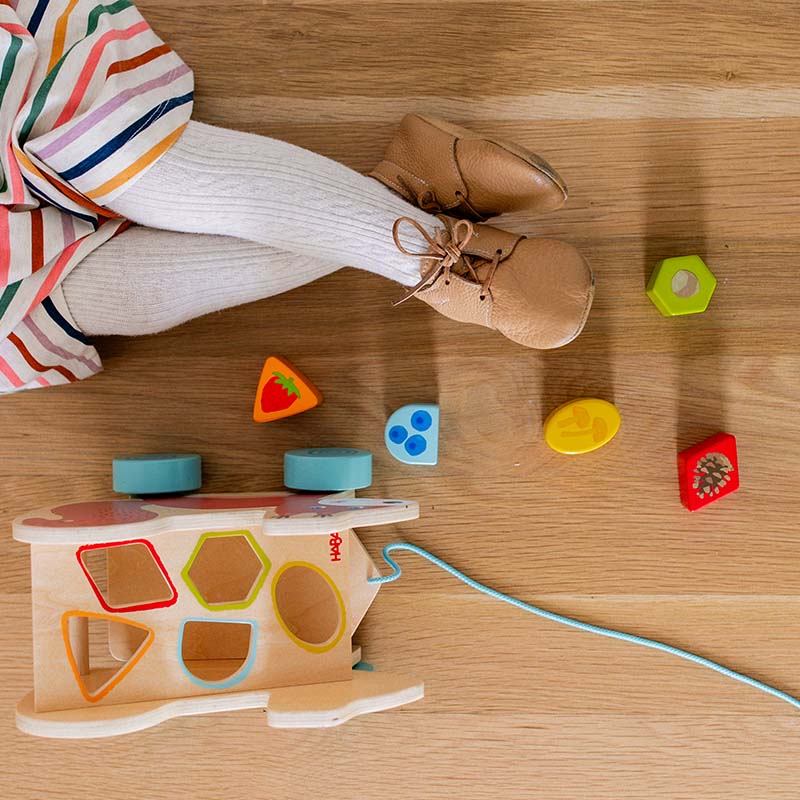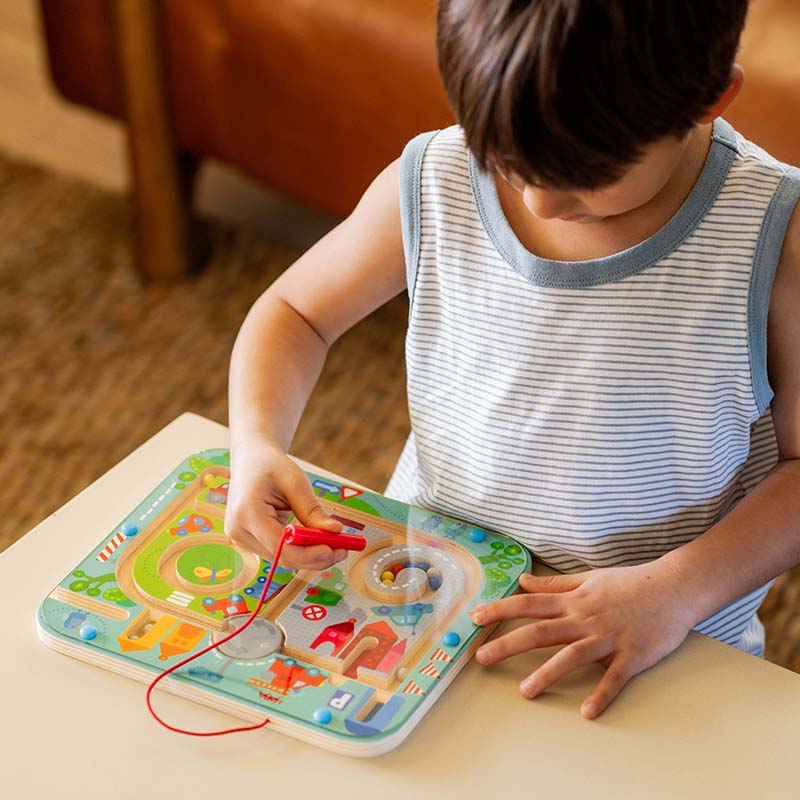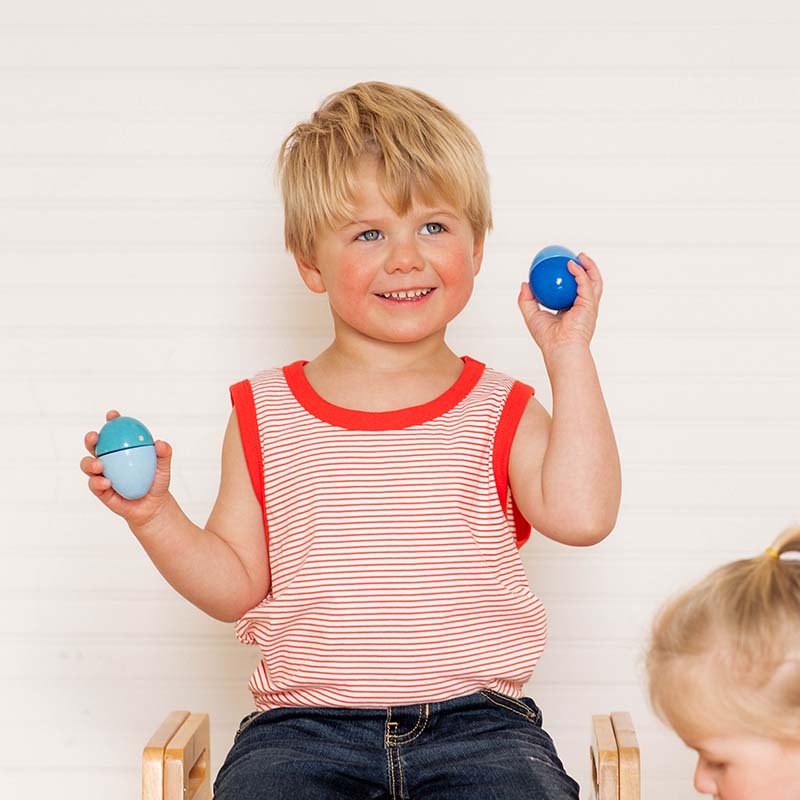“Children become like the things they love.” ―Dr. Maria Montessori
Perhaps your child goes to a Montessori preschool or you took an early education class and so you know all about Dr. Maria Montessori’s trailblazing pedagogy. But for many new parents, they might nod their head when they hear that a certain toy is considered to be a Montessori toy, but secretly wonder what exactly that means.
To go through the entirety of the Montessori method would take us a while, but having a little background as you approach the toys that create enriching learning moments is more approachable. The most important toys in the Montessori philosophy, according to Dr. Maria Montessori, "lend interest to activity and invite the child to conduct their own experiences."
But understanding exactly what makes a toy that allows your child to become independent and free to conduct their own experiences can be confusing, especially with the millions of choices out there. At HABA, we love making toys that support this philosophy and most of our toys fit neatly into the definition of what a Montessori toy should do and be.

What Is Montessori?
But first, let’s start with a little background on the history of this educational philosophy and what a Montessori classroom looks like. The Montessori method was created by Dr. Maria Montessori, a trailblazing Italian doctor, who in the early 1900’s broke gender barriers, fought for women’s rights, and believed in educating all children, especially those with learning challenges. At the heart of her philosophy is the importance of promoting independence in even the smallest child. She did this through carefully preparing the learning environment with a specific set of “educational tools” and allowing children to “work” at their learning at their own pace with uninterrupted work time.
Typical Montessori classrooms are filled with beautiful learning tools that are often made from natural materials. Various stations are set up throughout the classroom and children work through the curriculum at their own pace, accelerating during some tasks or taking additional time with others. Open shelves are set up with a variety of “works” that correspond to the curricular area (number works and letter works, for example), which children can pull down and set up on a table or on the floor, repeating the ‘work’ until they have mastered it or are ready to move onto another exploration. Throughout their day children invent, experiment, discuss, create, prepare snacks, and curl up with books, and explore the world around them through play and learning objects.

What Makes a Montessori Toy a Montessori Toy
It is those ‘learning objects,’ also known as toys, that make up much of the Montessori classroom. And while there are no “official” Montessori-certified toys, certain toys best mirror the philosophy and promote the characteristics that Maria Montessori emphasized as vital for the young child’s development and growth.
The most important quality is that toys should spark curiosity while allowing for the repetition of skills that mirror those needed in a child’s daily life. That is a pretty broad category so we have outlined some more specific characteristics to look for when choosing toys that will work well within a Montessori style play space.
- Toys that Are Made from Natural Materials: Children learn by using multiple senses at the same time. Montessori philosophy emphasizes this sensory-rich learning and believes that toys made from natural materials like cotton, wood, and metal, ignite the senses.
- Toys that Are Free of Distractions: Toys used in the Montessori classroom don’t have a lot of distracting noises, lights, or sounds (think battery-operated). The toy needs to be manipulated by the child so that they learn from the action created and then can make their own meaningful connections between cause and effect.
- Toys that Are Rooted in Reality: There is a lot of debate around this characteristic because Montessori philosophy does indeed encourage imaginative play, however Dr. Montessori believed that children should first play with toys that accurately reflect the world they see before they embrace the world of fantasy. So for example, early childhood Montessori classrooms might have a farmyard with realistic animal figures versus a magical scene with dragons and wizards.
- Toys that Teach One Skill at a Time: As mentioned above, having few distractions also allows children to focus on mastering one skill at a time. Just as having too many toys for a child to choose from can be overwhelming, a toy with too many features can prevent deeper learning. Montessori-aligned toys tend to have one specific purpose, for example a hammer tapping toy.
- Toys that Are Child-Sized and Have a Purpose: Speaking of purpose, in the Montessori classroom, there are always a myriad of tools, tableware, and utensils that are child-sized. These smaller-sized but realistic and functional tools allow kids to help with daily tasks, learn how to use everyday tools, encourage independence, and help children become a part of the community through helping to care for their surroundings.
- Toys that Encourage Independence: Those child-sized tools are one example of toys that encourage independence while other toys do this by allowing children to create their own open-ended play scenarios without needing to follow a lot of instructions or prescriptive steps. Block play is a great example of this open-ended play that also encourages independent thinking.
- Toys that Promote STEM Skills and Cause and Effect: Exploration is a big part of the Montessori philosophy so providing your child with lots of toys that allow them to test and experiment will help them to make sense of the world. As they play with these type of toys, children develop an initial understanding of important concepts like physics and math. Montessori-aligned toys like marble runs are a study in cause and effect, problem solving and spatial relationships.
- Toys that Encourage Repetition: When children work with a simple challenge repeatedly, strong connections emerge in their brain and learning happens. As they master simple repetitive tasks, their dexterity improves, their spatial connections are enhanced, and then they can move onto more complex tasks. An example is how threading games prepare young children for the important work of sewing in the Montessori classroom.
Why So Many HABA Toys Fit the Montessori Model
When you look through the HABA catalog of toys, there are a lot of toys that meet the above criteria. Our primary goal at HABA is to encourage children's innate sense of wonder and love for learning, so all of our kids toys are designed with that in mind. Many of our toys are made from wood, promote open-ended play, are fired by the imagination and not batteries, and encourage STEM learning. We also have several lines of games, tools, and toys that promote independent play and learning. Choosing just 10 was not an easy task but these are the ones that you will most often see in a Montessori classroom.

HABA’s top 10 Montessori-Inspired Toys
- Basic Building Blocks 102 Piece Extra Large Wooden Starter Set: These beautifully crafted blocks hit so many buttons for Montessori-aligned play things. They are open-ended, promote cause and effect and STEM learning, allow for discovery, promote independence, and are made from natural materials.
- Set of Five Wooden Musical Eggs: A favorite in Montessori classrooms, musical eggs foster color recognition and auditory discovery. They promote repetition as children shake to create the gentle sounds and encourage exploration of early music and rhythm while enhancing sensory learning. And are made of natural materials.
- Rainbow Whirls Wooden and Stacking Game: This HABA classic toy is also a Montessori learning favorite. The solid wooden board holds 16 brightly colored wooden pegs and 16 rings that are just right for little hands. Montessori skills of independence, repetition, no distractions, and focusing on one skill at a time are reasons why this is a toy that is often part of Montessori shelf work. We have a variety of wooden stacking and sorting games to choose from as well.
- Geo Shape Tack Zap: Another classic HABA which has been around for generations, this toy allows children to learn to hammer using real ½" nails and a wooden mallet. The realistic tools and practical skills developed make it an ideal Montessori-aligned play item. Also, children work on repetition, one task at a time, and as they create an infinite variety of patterns and pictures, they learn about geometry and spatial relationships.
- Spielstabil Child-Sized Rakes and Shovels: Child-sized garden tools, shovels, and rakes give children purpose and a sense of independence. These extremely durable tools will last for years of helping and will also help to build pride and self-esteem in a child as they learn about being responsible and the value they can bring to any task.
- Terra Kids Magnifying Glass: Similarly to our line of rakes and shovels, our Terra Kids products encourage kids to explore and become naturalists with child-sized binoculars, field microscopes, and more. Most Montessori classrooms will have a magnifying station to allow kids to look closely at things like seeds and textiles. These tools encourage kids to be curious and independent while promoting STEM learning.
- Town Maze Wooden Magnetic Game Puzzle: Just like the toys above, this simple and captivating toy is often found is Montessori classrooms because it represents so many qualities of the Montessori philosophy as children independently navigate the magnetic paths. Each twist on the maze encourages children to actively problem-solve and concentrate as they explore the different routes. Made from natural materials, our wooden magnetic maze boards encourage repetition and cause and effect.
- Wooden Marble Runs: These incredibly beautiful track sets made from natural materials cover so many Montessori bases. They are open-ended and allow children to explore, experiment, and create multiple pathways and runs. They allow for deep focus and problem-solving, paving the way for an early understanding of physics concepts and engineering. Kids create the momentum themselves, as opposed to the toys making distracting noises, and therefore the learning is cemented in their neural pathways.
- Rainbow Caterpillar Counting Threading Game: Threading toys teach fine motor skills and hand-eye coordination while also fostering imagination, creativity, and planning. Add in the calming effect of "sewing" and you have a toy children will gravitate to time and time again.
- Squirrel Pull Along Sorting Box: Montessori is all about getting the most benefits from the simplest toys and with this wooden toy, so many skills can be accomplished at once. Little ones can learn basic shapes, color recognition, enhance their dexterity and physical activity by pulling the box. This toy gives children engaging and purposeful moments of play where they can work independently.



























Leave a comment